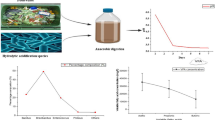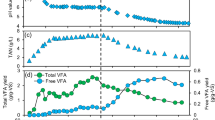Abstract
The application of sludge digestion systems to remove pathogens has been employed to generate biosolids suitable for reuse in agriculture. Traditionally, temperature is considered the principal agent responsible for pathogen reduction in anaerobic digestion. However, other substances such as volatile fatty acids may also have an antimicrobial effect. The objective of this study was to assess the impact of fatty acid mixtures on the inactivation of C. perfringens over a range of digestion temperatures. An equimolar mixture of acetic acid, propionic acid and butyric acid was applied to digester effluent for a period of 24 h at temperatures of 35 °C, 42 °C, 49 °C and 55 °C. C. perfringens inactivation in digester effluents, when dosed with volatile organic acids, was found to depend on pH, acid concentration and temperature. Temperatures above 55 °C appeared to increase the inhibitory effects of the organic acids at higher concentrations. An interaction between temperature and pH on survival of C. perfringens was observed. The results suggest that high concentrations of organic acids at a pH value of 4.5–5.5 during thermophilic digestion substantially reduce concentrations of C. perfringens in municipal sludge.



Similar content being viewed by others
References
Abdul P, Lloyd D (1985) Pathogen survival during anaerobic digestion: fatty acids inhibit anaerobic growth of Escherichia coli. Biotechnol Lett 7:125–128
Aitken MD, Walters GW, Crunk PL, Willis JL, Farrell JB, Schafer PL, Arnett C, Turner BG (2005) Laboratory evaluation of thermophilic-anaerobic digestion to produce Class A biosolids. 1. Stabilization performance of a continuous-flow reactor at low residence time. Water Environ Res 77(7):3019–3027
American Public Health Association (1999) Standard methods for the examination of water and wastewater, 19th edn. American Public Health Association, Washington, DC
Anderson GK, Yang G (1992) Determination of bicarbonate and total volatile acid concentration in anaerobic digesters using a simple titration. Water Environ Res 64:53–59
Bitton G (1994) Wastewater microbiology. Wiley-Liss, Inc., New York, NY
Carrington EG, Harman SA, Pike EB (1982) Inactivation of Salmonella during anaerobic digestion of sewage sludge. J Appl Bacteriol 53:331–334
Chauret C, Springthorpe S, Sattar S (1999) Fate of Cryptosporidium oocysts, Giardia cysts, and microbial indicators during wastewater treatment and anaerobic sludge digestion. Can J Microbiol 45(3):257–262
Demeyer DI, Henderickx HK (1967) The effects of unsaturated fatty acids on methane production in vitro by mixed rumen bacteria. Biochimica Et Biophysica Acta 137:484–497
Fukushi K, Babel S, Burakrai S (2003) Survival of Salmonella spp. in a simulated acid-phase anaerobic digester treating sewage sludge. Bioresour Technol 86:53–57
Goepfert JM, Hicks R (1969) Effect of volatile fatty acids on Salmonella typhimurium. J Bacteriol 97:956–958
Kashket ER (1987) Bioenergetics of lactic acid bacteria: cytoplasmic pH and osmotolerance. FEMS Microbiology Rev 46:233–244
Merck KGaA (2003) Merck index [online] Available from http://emdchemicals.com/nSearch/TransView.aspx?fn = 1.10235_1.10235.0500.htm&Sku = 1.10235.0500
Padan I, Zilberstein D, Schuldiner S (1981) pH homeostasis in bacteria. Biochimia Biophysica Acta 650:151–166
Puchajda B, Oleszkiewicz J (2003) Single and two-stage anaerobic digestion: hydrolysis, acidification and pathogen inactivation. In: Proceedings of WEFTEC 03, Los Angeles, California, LA, USA, 12–15 October 2003
Puchajda B, Oleszkiewicz J (2004) Pathogen inactivation through organic acids in anaerobic digestion. In: Proceedings of WEFTEC 04, New Orleans, LA, USA, 2–6 October 2004
Salsali HR, Parker WJ, Sattar SA (2006) Impact of concentration, temperature, and pH on inactivation of Salmonella spp. by volatile fatty acids in anaerobic digestion. Can J Microbiol 52(4):279–286
Schafer PL, Farrell JB (2000) Turn up the heat. Water Environ Technol 12:27–35
Taherzadeh MJ, Niklasson C, Linden G (1997) Acetic acid - friend or foe in anaerobic batch conversion of glucose to ethanol by Saccharomyces cerevisiae. Chem Eng Sci 52:2653–2659
Watanabe H, Kitamura T, Ochi S, Ozaki M (1997) Inactivation of pathogenic bacteria under mesophilic and thermophilic conditions. Water Sci Technol 36:25–32
Author information
Authors and Affiliations
Corresponding author
Rights and permissions
About this article
Cite this article
Salsali, H., Parker, W.J. & Sattar, S.A. The effect of volatile fatty acids on the inactivation of Clostridium perfringens in anaerobic digestion. World J Microbiol Biotechnol 24, 659–665 (2008). https://doi.org/10.1007/s11274-007-9514-4
Received:
Accepted:
Published:
Issue Date:
DOI: https://doi.org/10.1007/s11274-007-9514-4




